







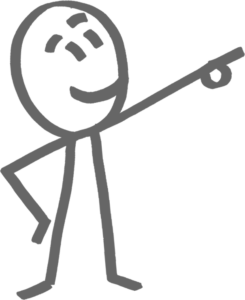

NLP (neurolingoistic programming) trainer and coach
This is the second part of the interview with Antonio Meza. In the first part we talk about Antonio’s life story and his career as an NLP (neurolingoistic programming) trainer and coach. We looked at the combination of NLP and graphic facilitation and how to record sessions using an iPad. In the second part Antonio gives you an introduction into symbolic thinking.
Everyone uses symbolic thinking and we don’t have to learn it. For example a person with hanging shoulders and a sad face would be seen as not resourceful while a person on top of the mountain in superman posture would be seen as very energetic. Here it doesn’t matter whether it is a real person or a stick figure drawing.
Symbolic thinking describes the process of creating an internal representation of a situation, scene or thought. We use all of our senses to imagine a situation and create our own internal representation. Every person is different so that everyone creates his own emotional reaction about the scene.
Understanding the concepts of symbolic thinking makes you a better graphic recorder as you can use those metaphors to tell more engaging stories even about the most boring topics. Just ask what the topic means for the people in your story and find the right metaphor.
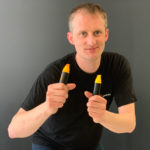
Marcel combines agile team coaching with visual thinking. Marcel believes that a group of people drawing together on a whiteboard can change the world. He loves high-performing teams and therefore coaches teams every day.

Antonio Meza is born in Mexico and has been drawing and sketching his whole life. He started his career as a cartoonist animating stick figures between 2 keyframes across the screen. He moved to Paris where he studied communication science and became a trainer and coach for neurolinguistic programming (NLP).
In the first part, Antonio introduces you into NLP and the science behind language patterns, body language and our eye movements. We clarify misunderstandings about NLP and talk about coaching contracts and the right coaching setting in general.
Antonio experience in coaching made him the perfect match to illustrate a book about success factor modelling which turned into the illustration of three books around the subject.
We talk about graphic recording using digital tools like iPad and ask the million-dollar question about his favourite iPad app for graphic recording on an iPad.
From here we give an introduction into symbolic thinking which we have decided to split the podcast into an extra episode about symbolic thinking.

Marcel combines agile team coaching with visual thinking. Marcel believes that a group of people drawing together on a whiteboard can change the world. He loves high-performing teams and therefore coaches teams every day.

Carola Keitel and Frank Wesseler are an amazing team. They met through the bikablo® Akademie in Cologne and became a couple. Carola always had the idea of travelling the US and maybe working there one day. So when she met Frank they put their energy together as a couple and made it possible. For me, this is an amazing story where you can see what a couple can do when they combine their strength and make things happen.
In the interview, we talk about it in detail. How it all started with a vague idea. How the things then came together and have a look at their travel plan. After the IFVP conference in Decatur, they travel from the east coast to the west coast and run 7 training in 10 weeks. It is an exciting trip from the east to the west and I can’t wait to introduce to you now Carola and Frank from the bikablo® Akademie in Cologne.
Have a look at their travel plan:

Marcel combines agile team coaching with visual thinking. Marcel believes that a group of people drawing together on a whiteboard can change the world. He loves high-performing teams and therefore coaches teams every day.



Design Thinking Trainer at LUMA Institute
Today I have the honour to have Patrick Sharbaugh with me. Patrick works for the LUMA institute, a training provider that enables companies and individuals to be more creative. He teaches design thinking and in this interview he gives us an introduction into the world of design thinking. We talk about creative problem solving, visual languages and what it means to have the customer in the centre of your solution design.
But first of all, let me introduce to you, Patrick. Patrick grew up in Charleston, South Carolina. He worked in Japan for a while and moved on to Vietnam where he worked in Saigon. In Saigon, he got in contact with the RMIT University and through that found his way to Australia. He works today in America as well as Australia as a trainer for Design Thinking, runs a Meet-up in the Melbourne CBD and is a great guy to meet every day.
We give you a step-by-step introduction into design thinking while we help Henry Ford to build a better car and explore why the Apple iPod 1 was important but not great.
I hope you enjoy this conversation with Patrick Sharbaugh from the LUMA Institute!

Marcel combines agile team coaching with visual thinking. Marcel believes that a group of people drawing together on a whiteboard can change the world. He loves high-performing teams and therefore coaches teams every day.

In this episode I talk about the first day back at work where you need to find a way to apply the new skills in your day to day job. We talk about positive psychology and how you can motivate yourself to progress your visual journey every day in the office. Additional we introduce the visual facilitation garage. An advanced visual facilitation workshop where you can meet people who are on the same journey as you. This workshop will be help every month in Sydney and Melbourne and is hosted in Germany as well for many years. I hope you enjoy this short episode!
Hey! Guys, this is Marcel again from the Bikablo Radio with another insight episode.
Today I want to talk about the third day of the Bikablo training. If you have a look at the Bikablo training program in Australia you might say “There is no third day in the training”, and that’s right.
There is a two days training when you come to the Bikablo fundamentals and practitioner level, but what I mean is the third day, which is the first day when you’re back at work.
At work, the real change happens. You need to find ways to practice and apply the things you learnt on a daily basis. Here you might go through very mixed feelings.
First of all, you get a lot of positive feedback because people come to you and say Oh! My god, when have you learned to draw. I didn’t know that you could do that. That will actually happen, l promise you that, but as with everything new you also will not get it right the first time and you need to be OK with it.
What I mean is that you will not do the same performance you did in the training class. In the training room you had a safe environment and could explore the tools and techniques in your own speed. At work the speed of the others matter and outcomes become more important then the beauty of your lines. Very simple things that you had mastered in the training class are difficult again like drawing the light bulb or simple shapes like boxes and arrows.
Recently, I came across the work from Barbara Fredrickson, she is a scientist with more than twenty years experience in positive psychology. She wrote several books including Love 2.0 and Positivity.
On of her concepts which hit me and I really like is the “tipping point”. It is the ratio between positive and negative emotions and how to balance those feelings in a positive way: According to Barbara’s works, you need about three positive emotions to equalize one negative emotion.
That means for every line you draw not straight or every light bulb pictogram that looks a bit out of shape and funny, you need to celebrate three things that you did right and that you are happy about. The problem is when you tip over to the negative side you are more likely to stop the change you started in the training and through that you would have wasted time and training budget.
So how can you make sure that you get a healthy ratio between your positive emotions so that it equalizes the negative emotions out which will appear most definitely.
First, you celebrate everything that you got right and through that motivate yourself. That could mean that you are proud about your neat writing or the bikablo® containers and frames you swapped your content in. Or the strategic use of colours and the way you applied the shadows and highlights – every little success counts towards the positive emotions ratio. Please open your eyes and celebrate those little successes at work every day.
Secondly, I would like to introduce to you another great concept of Barbara Fredrickson work where she describes “micro moments of connections” between people. Those are the beautiful moments when two people see each other. It’s when you understand each others needs and feel connected with someone.
Of course you need a person you trust and can be open to. It’s a person that has a smile always ready for you at work. In our corporate world we need those good mates so that we can support each other every day. When starting visual facilitation you reactivate your drawing skill that you had almost forgotten since childhood and you need good mates that give you constructive feedback to progress further.
However, even if you have great people at work it is very hard for them to offer feedback to you as you probably do something new they have no own experience in. Therefore they struggle to support you even if they would like it.
Here the bikablo® Akademie will not let you down, we present to you the new bikablo® Visual Facilitation Garage. An advanced half-day bikablo® workshop in Sydney and Melbourne that brings together bikablo® graduates to practice, learn and grow together as visual leaders. If you are in German speaking Europe – The visual facilitation garage is also hosted in Germany.
You will get feedback about your work and see what you have already mastered and where you need to improve next. You will learn from someone who is on the same journey as you or just a couple of steps ahead!
I hope that the bikablo® Visual Facilitation Garage can provide you not only with necessary feedback but also creates those awesome “micro-moments of connection” that everyone need to reenergize their batteries so that you stay on track and become a visual ninja at work.
I hope to see you soon in Melbourne or Sydney in the Visual Facilitation Garage. Thank you very much and have a great week.

Marcel combines agile team coaching with visual thinking. Marcel believes that a group of people drawing together on a whiteboard can change the world. He loves high-performing teams and therefore coaches teams every day.


What is Visual Facilitation about?
This hot air balloon acts as a symbol for sharing the same context. As the facilitator, I have one key assumption which is, that best collaboration can happen if we create real exchange between people. What I mean is basically showing more of ourselves to each other. If we do that we exchange much more than just content – we create a real emotional relationship! Drawing together is a great way to achieve that emotional connection.
I think the real exchange is actually the only way how organisations can do change and create an engaging culture that helps them to thrive.
Coming back to the group being in the same meeting: What this group wants to achieve is to come to the desired outcome or do a change together.
The progress during the meeting is not linear, often the meeting has many ups and downs and hopefully ends successfully. This is where the role of the facilitator comes into play. So let’s have a look at the facilitator first.
As a facilitator, I’m a guide that leads the group through these ups and downs. The facilitator is not part of the group, he is not working in the content, he is more the creator of the working environment so that the group can have this real exchange and collaborate well. So what is now a visual facilitator doing?
I think the real exchange is actually the only way how organisations can do change and create an engaging culture that helps them to thrive.
Coming back to the group being in the same meeting: What this group wants to achieve is to come to the desired outcome or do a change together.
The progress during the meeting is not linear, often the meeting has many ups and downs and hopefully ends successfully. This is where the role of the facilitator comes into play. So let’s have a look at the facilitator first.
As a visual facilitator, as the word says, we make things visible. We listen to statements, quotes and ideas, but we also look for hidden things, like emotional positive reactions or conflicts. We are able to raise awareness around that in a neutral way.
A good friend of mine, Martin Haussmann, says: A visual facilitator is like being the marker – being the pen for the group.
So we bring onto this canvas what the people say and through drawing it we reflect it back to the group. We are acting as a mirror for the group process and help them through that change.
We are quite often not completely aware what the detailed discussion is about and that is not needed because we’re working a bit underneath the content layer. In this way, it doesn’t replace meeting minutes. We create a richer picture but not a detailed summary.
Let’s say we capture a 2-day conference, then it could be that the screen is 10 meters wide. At the beginning of the first day it is almost empty, it might have a headline or a topic on it. However, through the progress of the days, we capture what happened and by the end of the conference, we have created a timeline of insights.

Graphic Recording at Agile Australia
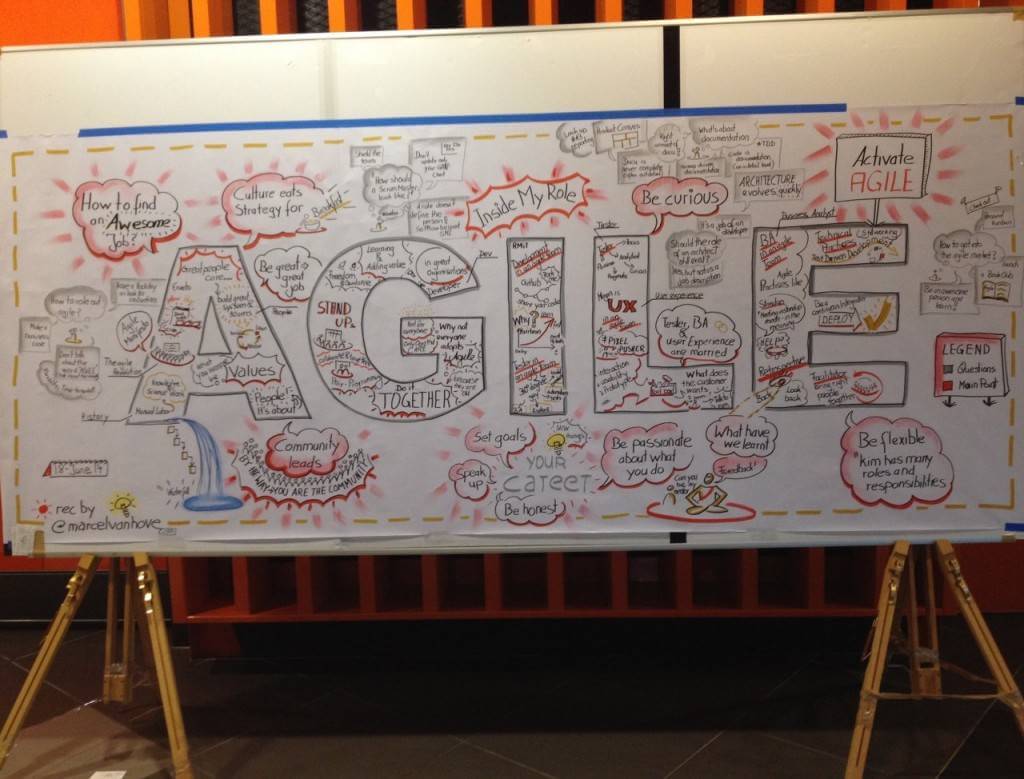
A facilitator is in charge of the dialogue, the exchange in the group. He creates space for collaboration. That’s true for the visual facilitator as well but he also captures the insights on a big screen and reflects them back to the group to inspire them to work further. Through that, we create a visual summary of what has happened. We actually make the dialogue visible.
If you liked what I just explained, or if you need a visual facilitator just shoot me an email or call me. If you want to learn it yourself come to my next visual facilitation training class. And follow me on twitter

Marcel combines agile team coaching with visual thinking. Marcel believes that a group of people drawing together on a whiteboard can change the world. He loves high-performing teams and therefore coaches teams every day.

Attending the bikablo® visual facilitation training is only 50% of the deal. You need to apply it and keep practising on your day-to-day job. One of the best ways to improve your visual facilitation skills is by learning from each other in a community of practise. In this short episode I talk about different communities of practise I have been part of in my career and would like to invite you to join the bikablo® graduates group on LinkedIn.
I would like to ask you a question. Are you part of a community of practice? Now, you might wonder, what is he talking about? Okay, let’s look into the words step-by-step and see what a community of practice means.
Are you part of a community? You’re part of a country, which is already a community. You’re part of a family, and you may be part of a work environment.
All those are communities. However, you might not think of it as a place where you learn from each other new techniques, tools or crafts because most communities are diverse and share little in common.
This is different in the community of practice. A community of practice, you meet like-minded people who want to learn the same thing in life and therefore exchange their experience.
You look for people who have achieved something you try to master right now and they act as a mentor for you. At the same time you become a leader for others. This creates a network of people learning and growing together their skill set.
Let me give you an example of a community of practice I was part of. When I first heard about the extreme programming, I was very excited to figure out what this agile approach of delivering software would mean and how I could apply it to my world.
I looked into the extreme programming (XP) community by following online discussions, attending user groups to meet like-minded people. That helped me to explore this new topic I had heart about in the podcast. I learnt from other and probably asked every question you can ask twice.
Same again when I got into visual facilitation. I discovered visual facilitation as an awesome way to interact and collaborate with people. It helps to convey my message across to the people I work with every day.
However, in the beginning it was not the easiest thing to start drawing live on a white board while people looking at your drawing and spelling mistakes. So hearing from other graphic recorders and visual facilitators about their journey helped me to learn and grow.
So why is a community of practice so important? For me this all comes back to our human needs. Let’s have a look at the Maslow’s Hierarchy of Needs. The fundament of that step ladder is safety and the fulfilment of your physiological needs. Like food and shelter. I am quite confident that you have reached that level by the pure fact that you have conditions in life that enable you to listen to this podcast. If you would worry about food and shelter you probably would not have the capacity to think about this podcast.
The next level in the Hierarchy of Needs is love and belonging. Communities of practise help at this point because it provides a group of people who like to do the same things you like and everyone shares their experience. You notice that your challenges are not so different from others and that someone found a solution for your problem already.
Level up on Maslow’s ladder again and we talk about esteem or acknowledgement by others. Esteem gives you the feeling that you are on the right track. I often come home from Meetups and have the feeling that I do well and should progress my path. I also feel good because I could help others on their journey. Some people need more acknowledgement some people less. However, most people need a bit of the good feeling and the comfort that we are on the right track.
The final step in that hierarchy is the self-actualisation. Self-actualization is a tricky one. Some people say they just know what they should do in life and feel like they are called to do it. However for me this is not so clear – I enjoy learning new things and passing them on. For many it is the quest about what you want to do with your life and who you would like to become.
So why am I telling you that? First of all, I believe that coming to my bikablo® visual facilitation training is only 50% of your job. You need to find your community of practise, simply to keep practising and learning from others. If you are from Melbourne or Sydney we have Meetups around visual facilitation. The Melbourne Meetup is hosted by me and you are welcome to learn about visual facilitation even if you haven’t participated in a bikablo® training.”
However, there is more. I’m very proud to present to you a new bikablo® community of practise. It is a closed network for bikablo® graduates that are now practising their visual thinking and facilitation skills on their day-to-day job. The group is hosted on Linkedin and every training attendee from the past got invited.
I believe that those communities are even stronger because you already made some commitment by coming to a bikablo® training. This online community of practice is a community where you find people that are one the same journey. They might have been in the training two-month earlier but we are on the same journey together. On top of that you can ask questions to other bikablo® trainers who hang out with you. The beauty is that each trainer is different. I apply bikablo® is the world of agile coaching and culture change but we have trainers who use bikablo® for process mapping, business consulting or counselling. All bikablo® trainers together have more than 150 years of visual facilitation experience.
If you have participated in a bikablo® training in Europe, Australia or Asia. Please accept my invite to the bikablo® graduates community. If you haven’t been to a bikablo® training just follow the link below and join the bikablo® community of practise tomorrow.
Please remember that the training is just the kick-start. You need to keep the engine running and learn on daily bases.
Thank you very much for listening to bikablo® insight, and I hope to see you in one of the trainings in Sydney, Melbourne or anywhere in Europe.

Marcel combines agile team coaching with visual thinking. Marcel believes that a group of people drawing together on a whiteboard can change the world. He loves high-performing teams and therefore coaches teams every day.



Helping others is natural to us but asking for help is sometimes difficult to many. The reason behind lays in the way we grew up, how we were raised and not at last in a school system that was focused on competition and performance not on collaboration and creative thinking. However, todays challenges in business lay in the ability to solve complex problems together as a team and for me one of the most important steps to become a strong team is to overcome the fear of asking for help and embrace the fact that nobody is perfect. Through that asking for help becomes a personal strength. Remember todays problems are just too complex for one brain anyway.
In this insight episode I walk you through a scenario how you can offer help as a visual leader. You don’t have to be the subject matter expert – just a good listener with a pen using a whiteboard. Often it is enough that the person who has the problem steps out of the problem space for a moment and explains the challenge to someone else. I explain you my 8-steps to help him/her to unblock any problem solving. By following the 8-steps you have a chance to engage even more people of your team in the solution design and through that improve your team and company culture on the long run. These steps are not always strictly followed, they shall be a guide to get started as a visual leader on a whiteboard.
I hope you enjoy this episode! Please share it in your network if it is useful for you.

Marcel combines agile team coaching with visual thinking. Marcel believes that a group of people drawing together on a whiteboard can change the world. He loves high-performing teams and therefore coaches teams every day.


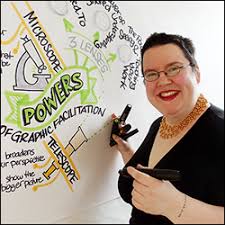
Founder Loosetooth.com
This episode is a great personal career story of Brandy Agerbeck from loosetooth.com. Brandy gives an insight into her career, including how she started as a knowledge worker with the MG Taylor model and how she went out on her own as a graphic facilitator a couple of years later.
She gives insights into her work including the Brandyfesto, Draw Quad and the process of writing her new book “The Idea Shapers“.
We talk about her TEDx Talk in Windy City in 2013 and chat about the future and where visualisation heading. If you would like to learn what a sneezy green person is then listen to this episode of Visual Friends Radio with Brandy Agerbeck from loosetooth.com.
If you are interested in meeting Brandy, please join her in her Winter or Sommer Lab in Chicago. A three day immersion where you will learn from Brandy firsthand.

Marcel combines agile team coaching with visual thinking. Marcel believes that a group of people drawing together on a whiteboard can change the world. He loves high-performing teams and therefore coaches teams every day.


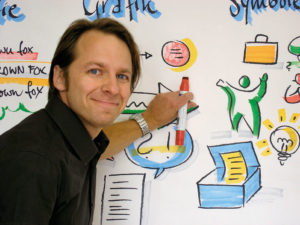
Director of the bikablo® company for visual storytelling, graphic recording, visual facilitation and visual consulting
This episode looks beyond the horizon: We start with a comprehensive introduction into the world of visualisation and go down the rabbit hole into group facilitation and conflict solving through drawing together. When we come out again, we go 12 years back in history and talk about the early days of visualisation when bikablo® wasn’t known at all. How the systematic bikablo® technique appeared and what the three pillars of bikablo® are about. We then look into the future and explore areas that bikablo® could explore in the future.
We look into different cultures and how other cultures use visuals in different ways. Over the last 12 years we have just started to learn about visual thinking and there is much more to explore.

Marcel combines agile team coaching with visual thinking. Marcel believes that a group of people drawing together on a whiteboard can change the world. He loves high-performing teams and therefore coaches teams every day.

